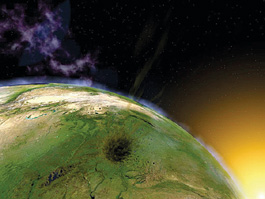home | metro silicon valley index | columns | car culture

Car Culture
Gorey Truth
By Novella Carpenter
SUMMER MOVIE SEASON is upon us. While many people are hankering to see Tom Cruise do another impossible mission, and others are clamoring for the stupid fun of Nacho Libre, a more somber film should also be a contender for your attention: An Inconvenient Truth. Yes, the Al Gore movie.
Next week, I'll preview all the car-related summer movies that you must see, but I think An Inconvenient Truth (which opens June 2) warrants its own column. There are no explosions or slapstick routines, but Al Gore plays a role he hasn't played before: human being. Even though I'll never forgive him for bowing out from the election recount in 2000, I have always thought that Gore isn't as bad as most politicians. In the movie, he is better than usual. Gone are his robotic movements, his lack of passion. But what really steals the show is the unquestionable reality of global warming. The threat of nuclear war was the biggest fear for the world at the end of the 20th century; climate change will be the major issue this generation faces.
Although I have barraged you with dozens of antidotes over the years—EVs, biking, hybrids, biofuels—perhaps this movie will help change the minds of the majority. Writing in The New Yorker, David Remnick says the movie "is not the most entertaining film of the year. But it might be the most important."
Gore's relationship with global warming began 26 years ago when he held the first congressional hearing about the subject. It was 1980, and Rep. Gore had heard about the increased carbon dioxide levels because of fossil-fuel usage from geophysicist Roger Revelle. Revelle was one of the first scientists to alert the U.S. government in the 1960s of the potential issues with excess carbon dioxide. In 1977, the National Academy of Sciences issued a study called "Energy and Climate" that first hinted at global warming.
During the 2000 election, George W. Bush used Gore's stance on global warming as a weapon to convince voters that Gore was a wacky environmentalist—so much so that Gore dropped climate change as a major platform issue. After "losing" the election, Gore decided to go on the road and campaign about something he was truly passionate about: climate change. While Bush refused to sign the Kyoto Treaty, because, he said, "No one can say what a dangerous level of warming is," Gore gave slide show after slide show that illustrated the problem of global warming. The movie follows that potentially boring plot line but somehow maintains the drama of a world warming dangerously. At the movie's website, there is a Take Action section that invites you to calculate your carbon impact on the world. It reads, "We all contribute to global warming every day. The carbon dioxide you produce by driving your car and leaving the lights on adds up quickly. You may be surprised by how much CO2 you are emitting each year." The series of questions includes what kind of car you drive, how often you drive and how many flights you take. The American average is 15,000 pounds of carbon dioxide emitted every year. I calculated my carbon load and found that I emit 12,000 pounds. And I'm all eco-groovy. What's a person to do? The Gore site recommends paying for your guilt by contributing money to offset carbon through investment in wind power or methane-plant construction. The site also suggests some ways to offset your carbon by using carpools and public transportation. Telecommute.
Of course, there has been a backlash from the right wing, which still denies the human impact on global warming. A group called the Competitive Enterprise Institute has unveiled a series of ads that addresses Gore's "global-warming alarmism." In one of the spots about carbon dioxide, a woman's soothing voice says, "They call it pollution; we call it life." This is what Gore's been battling this whole time.
Contact Novella Carpenter or send a letter to the editor about this story.
|
|
|
|
|
|